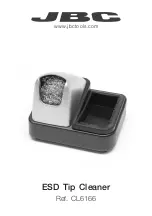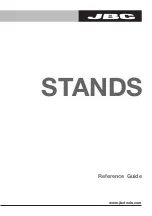
3
SERVICE
• Have your power tool serviced by a qualified repair
person using only identical replacement parts.
This
will ensure that the safety of the power tool is maintained.
• Never service damaged battery packs.
Service
of battery packs should only be performed by the
manufacturer or authorized service providers.
SPECIFIC SAFETY RULES
FOR HEAT GUNS
READ THESE INSTRUCTIONS
• Know your work environment.
Hidden areas such
as behind walls, ceilings, floors, soffit boards and
other panels may contain flammable materials that
may ignite when using the heat gun in these loca-
tions. Ignition of these materials may not be readily
apparent and could result in property damage and
personal injury. Check these areas before applying
heat. If in doubt, use an alternate method. Pausing
or lingering in one spot may ignite the panel or the
material behind it. Keep heat gun moving to avoid
excessive temperatures.
• Do not direct the heat gun air airflow at clothing,
hair or other body parts. Do not use as a hair
dryer.
Heat guns can produce 1100°F (593°C) or
more of flameless heat at the nozzle. Contact with
the air stream could result in personal injury.
• Do not use near flammable liquids or in explo
-
sive atmospheres, such as in the presence of
fumes, gases or dust.
The flameless heat from
the heat gun may ignite the dust or fumes. Remove
materials or debris that may become ignited from
work area.
• Shield materials around the heated area
to pre-
vent property damage or fire.
• Keep a fire extinguisher nearby.
Heat guns may
ignite flammable materials left in the work area.
• WARNING! Hot Surfaces. Always hold the heat
gun by the plastic enclosure. Do not touch
nozzle, accessory tips or store heat gun until
the nozzle has cooled to room temperature.
The
metal nozzle requires approximately 20 minutes
to cool before it can be touched. Contact with the
nozzle or accessory tip could result in personal
injury. Place the heat gun in a clear area away from
combustible materials while cooling to prevent flam
-
mable materials from igniting.
• Do not cut off airflow by placing nozzle too close
to workpiece.
Keep intake vents clean and clear of
obstructions. Restricting airflow may cause the heat
gun to overheat.
• Place the heat gun on a stable, level surface
when not hand held.
• Do not leave the heat gun unattended while run-
ning or cooling down.
Inattention invites accidents.
• Store indoors in a dry location.
Do not expose to
rain or moisture.
• Do not direct airflow directly on glass.
The glass
may crack and could result in property damage or
personal injury.
•
Maintain labels and nameplates.
These carry
important information. If unreadable or missing,
contact a MILWAUKEE service facility for a free
replacement.
•
WARNING
Some dust created by power sanding,
sawing, grinding, drilling, and other
construction activities contains chemicals known to
cause cancer, birth defects or other reproductive
harm. Some examples of these chemicals are:
• lead from lead-based paint
• crystalline silica from bricks and cement and other
masonry products, and
• arsenic and chromium from chemically-treated
lumber.
Your risk from these exposures varies, depending on
how often you do this type of work. To reduce your
exposure to these chemicals: work in a well ventilated
area, and work with approved safety equipment, such
as those dust masks that are specially designed to
filter out microscopic particles.
IMPORTANT SAFETY INSTRUCTIONS
FOR REMOVING PAINT
WARNING
Use extreme care when stripping
paint. Peelings, residue and vapors
of paint may contain lead, which is POISONOUS.
Pre-1977 paint may contain lead and paint made
before 1950 is likely to contain lead. Hand to
mouth contact with paint peelings or residue from
pre-1977 paint may result in lead ingestion. Ex-
posure to even low levels of lead can cause ir-
reversible brain and nervous system damage.
Young and unborn children are especially vulner
-
able to lead poisoning. DO NOT REMOVE LEAD-
BASED PAINT WITH A HEAT GUN. Before begin
-
ning your work, determine whether the paint you
are removing contains lead. A local health depart-
ment or a professional who uses a paint ana-
lyzer can check the paint for lead content. LEAD-
BASED PAINT SHOULD BE REMOVED ONLY BY
A PROFESSIONAL.
Persons removing paint should follow these
guidelines:
• Work in a well ventilated area.
If possible, move
the workpiece outdoors. If working indoors, open win
-
dows and place an exhaust fan in a window. Be sure
the fan is moving air from inside to outside. Proper
ventilation will reduce the risk of inhaling chemicals
found in the fumes or dust created by using a heat
gun.
• Remove or cover any carpets, rugs, furniture,
clothing, cooking utensils and air ducts
to pre-
vent property damage from the paint peelings.
• Place drop cloths in the work area to catch paint
scrapings. Wear protective clothing
such as hats,
extra work shirts and overalls. Paint scrapings may
contain chemicals that are hazardous.
• Work in one room at a time.
Remove furnishings
or cover them and place in the center of the room.
Seal doorways with drop cloths to seal work area
from the rest of the building.
• Children, pregnant or potentially pregnant
women, and nursing mothers should not be near
work area
until all work is completed and work area
is cleaned thoroughly.
• Wear a dust respirator mask or a dual filter
(dust and fume) respirator mask
which has been
approved by the Occupational Safety and Health
Administration (OSHA), the National Institute of
Safety and Health (NIOSH), or the United States
Bureau of Mines. These masks and replaceable
filters are readily available at major hardware stores.
Be sure the mask fits. Beards and facial hair may
keep masks from sealing properly. Change filters
often. DISPOSABLE PAPER MASKS ARE NOT
ADEQUATE.
• Use caution when operating the heat gun.
Keep
the heat gun moving to prevent excessive tempera-
tures.
Excessive heat can cause paint and other























